![]() Nickerie.Net,
maandag 24 september 2007
Nickerie.Net,
maandag 24 september 2007
|
BESLISSING VAN HET ARBITRAGETRIBUNAAL |
|
Paramaribo - Het Zeerecht Tribunaal van de V.N. heeft
gistermiddag zijn uitspraak bekendgemaakt inzake het
eeuwenoude grensgeschil tussen Suriname en Guyana. Dit is
mogelijk geworden omdat het Secretariaat van het Tribunaal
de regeringen van Suriname en Guyana vooraf, maar onder
embargo, inzage had verschaft in het vonnis. Door president
Ronald Venetiaan werd gistermiddag omstreeks 17.15 uur
verslag uitgebracht aan de Surinaamse pers over de uitspraak
van het Zeerecht Tribunaal.
Vraag 8: Is Suriname van oordeel dat het resultaat van de
procedure redelijk en billijk is? Vraag 9: Welke rechtsregels heeft het Arbitrage Tribunaal toegepast? Antwoord: Het Zeerecht Verdrag van de Verenigde Naties (UNCLOS) bevat de rechtsregels die door een Tribunaal dat een zeegrens vaststelt, worden toegepast. UNCLOS bepaalt dat de vaststelling van de maritieme grenzen tussen landen moet geschieden bij overeenkomst tussen partijen en indien Staten niet in staat blijken overeenstemming te bereiken, kunnen ze een oplossing betrachten middels de uitspraak van een arbitrage tribunaal ingesteld ingevolge Annex VII van UNCLOS. Dat is de procedure die gevolgd werd door Barbados en Trinidad en Tobago ten aanzien van hun zeegrensgeschil. Dat was de eerste arbitrage ter vaststelling van de zeegrens onder UNCLOS; het geschil tussen Guyana en Suriname is de tweede arbitrage procedure van deze soort. Voor de territoriale zee bepaalt UNCLOS dat de equidistantie methode moet worden gehanteerd tenzij bijzondere omstandigheden een andere grenslijn noodzakelijk maken. De equidistantie methode kent bij een geschil tussen aangrenzende of tegenover elkaar liggende staten aan elke staat het gebied toe dat dichter bij zijn kust ligt dan bij de kust van de andere staat, zodat de grenslijn de lijn is die gevormd wordt door de punten die op gelijke afstand liggen van beide kusten. Onder UNCLOS dienen de begrenzing van het continentaal plateau en de exclusieve economische zone, (gebieden die gelegen zijn voorbij de territoriale zee), te geschieden op basis van het internationaal recht teneinde een billijke oplossing te bereiken. De beslissing van het Tribunaal is gebaseerd op deze regels van UNCLOS. Het Tribunaal besliste dat de 10 graden lijn die Guyana en Suriname vele jaren in acht namen een bijzondere omstandigheid was bij de begrenzing van de territoriale zee tussen Suriname en Guyana. Overeenkomstig de beslissingen van het Internationaal Gerechtshof en de beslissing van het arbitrage tribunaal in de arbitrage tussen Barbados en Trinidad en Tobago heeft het Arbitrage Tribunaal buiten de territoriale zee de equidistantie methode toegepast.
Vraag 10: Was de beslissing van het Tribunaal gebaseerd op
precedenten? Vraag 11: Wanneer werden de begrenzing van drie mijl,12 mijl en 200 mijl in het internationaal recht effectief? De grens van drie mijl werd door de koloniale mogendheden in acht genomen. UNCLOS werd aangenomen in 1982 en machtigde Staten om een grens van de territoriale zee van 12 mijl en een grens van de exclusieve economische zone en het continentaal plateau van 200 mijl aan te houden.
Vraag 12: Aan welk land is de locatie van het CGX incident
toegewezen? Dienovereenkomstig trok het Tribunaal een equidistantie lijn als de grens tussen Guyana en Suriname voorbij de 12 mijl grens. Omdat de locatie van het CGX- incident iets dichter bij Guyana ligt dan Suriname, viel het aan de Guyanese zijde van de equidistantie lijn. Andere olie ‘prospects’ die vielen onder de concessie die Guyana aan CGX had verleend, zijn echter aan Suriname toebedeeld. Met name de locatie van Wishbone’ die binnen de concessie lag die Guyana aan CGX had toegekend, ligt nu, als gevolg van de grenslijn die door het Arbitrage Tribunaal getrokken is, tenminste voor een deel binnen het Surinaams gebied.
Vraag 13: Zijn er nog andere olieconcessies getroffen? Ongeveer 1300 vierkante kilometers van de CGX -concessie en ongeveer 4300 vierkante kilometers van de Exxon concessie liggen nu binnen Surinaamse wateren. Figure 2 is een kaart waaruit de gevolgen van voor de bestaande Guyanese concessies zijn aangegeven.
Vraag 14: Waren er nog andere geschilpunten in de procedure
behalve de vaststelling van de zeegrens? Het Arbitrage Tribunaal heeft Guyana’s vordering voor $ 34 miljoen schadevergoeding gebaseerd op het CGX- incident integraal verworpen. Het Arbitrage Tribunaal heeft ook vastgesteld dat zowel Guyana als Suriname voor het CGX- incident hun verplichtingen ingevolge de artikelen 74(3) en 83(3) van UNCLOS niet behoorlijk zijn nagekomen.
Vraag 15: Het Tribunaal heeft Suriname’s handeswijze in het
CGX -incident bekritiseerd; wat is hierop het antwoord van
Suriname?
Vraag 16: Wat staat nu te gebeuren?
Vraag 17: Wat is het significante economisch belang van deze
beslissing voor Suriname en Guyana? Bron: Dagblad Suriname, 21 september 2007 |
Guyana krijgt leeuwendeel maritiem betwistgebied - President Venetiaan tevreden
Ivan Cairo, 21/09/2007
Paramaribo - Met de toegewezen 33.152 vierkante kilometer (12.800 vierkante mijl) krijgt Guyana het leeuwendeel van het maritieme grensgebied dat Suriname tot zijn grondgebied rekende. Suriname krijgt de resterende 17.871 vierkante kilometer (6.900 vierkante mijl). Dat heeft het Arbitrage Tribunaal inzake de VN Conventie over de rechten van de zee (UNCLOS) gisteren bekendgemaakt. Toch is president Ronald Venetiaan tevreden en verheugd over de uitspraak en doet hij een beroep op de samenleving deze te accepteren en te respecteren en ook tevreden te zijn. Vooral omdat nu definitief een einde is gekomen aan het dispuut met Guyana over het zeegrensgebied, een voor partijen bindende grenslijn is bepaald en de “drastische lijn” die Guyana wilde laten trekken is afgewezen. Ook de schadevergoeding van 34 miljoen US dollar die Georgetown had geëist, is door het tribunaal van tafel geveegd.
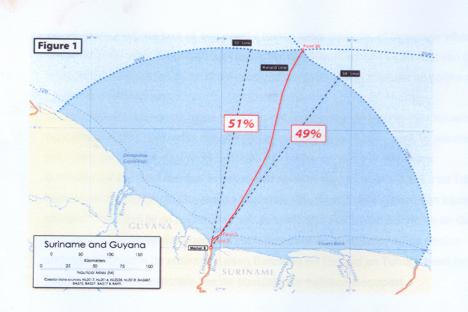 Zo
ziet de verdeling uit van het maritiem gebied, zoals die door het Arbitrage
Tribunaal inzake de VN Conventie over de rechten van de zee (UNCLOS) is verdeeld
onder Suriname en Guyana.
Zo
ziet de verdeling uit van het maritiem gebied, zoals die door het Arbitrage
Tribunaal inzake de VN Conventie over de rechten van de zee (UNCLOS) is verdeeld
onder Suriname en Guyana.
Suriname krijgt het rechterdeel groot 17.871 vierkante kilometer (6.900
vierkante mijl) en Guyana het linkerdeel van 33.152 vierkante kilometer (12.800
vierkante mijl). Het tribunaal bevestigde verder dat de gehele Corantijnrivier
van Suriname is.Het tribunaal heeft verder bevestigd dat de
gehele Corantijnrivier van Suriname is en, gelet op de grens die nu is getrokken
in de territoriale zee, heeft Suriname de ruimte om de scheepvaart in en uit de
Corantijnrivier te controleren. De vermoedelijke oliebron, Eagle, de directe
aanleiding voor het oplaaien van het maritiem grensgeschil in juni 2000, valt nu
binnen het gebied dat aan Guyana is toegewezen. De president hoopt dat eventueel
aan de Surinaamse kant van de zeegrens ook aardolie zal voorkomen. Eagle ligt op
8 mijl van de nu vastgestelde grenslijn.
Tijdens een persconferentie gistermiddag benadrukte Venetiaan dat met de uitspraak Suriname ongeveer 12.000 vierkante kilometer zeegebied extra bijkrijgt om daar voorkomende natuurlijke hulpbronnen te exploiteren. Zowel het staatshoofd als Paul Saunders, die Surinames case bij het tribunaal verdedigde, wees erop dat de verdediging succesvol is geweest, waardoor een aantal van Guyana’s claims zijn afgewezen. Zo werd de eis om de grens te laten lopen vanaf de 34 graden lijn afgewezen. Hierdoor liggen enkele olieconcessies die door Georgetown waren uitgegeven nu op Surinames territoir. Ook de claim dat Suriname geweld heeft toegepast om het CGX-olieboorplatform in 2000 te verjagen, is afgewezen. Wel werd Suriname op de vingers getikt dat met geweld is gedreigd. Ook Guyana is door het tribunaal berispt, omdat dat land tegen beter weten in concessies in een betwist gebied heeft uitgegeven en ook toestemming heeft gegeven om olieboringen te laten verrichten. Beide landen zijn bovendien bekritiseerd, omdat ze vóór het CGX-conflict onvoldoende hebben gedaan om in die periode provisionele afspraken te maken omtrent activiteiten in het toen nog omstreden gebied.
Dat Suriname de marine inzette om zijn soevereiniteit te verdedigen, is volgens Venetiaan ten onrechte als onwettige dreiging met geweld gekwalificeerd. Venetiaan riep Guyana op ermee in te stemmen dat de documenten en mondelinge pleidooien van partijen in deze zaak, openbaar worden gemaakt, “zodat eenieder hieromtrent voor zichzelf kan oordelen”.-.
Anti-climax in martiem geschil
21/09/2007 (dWT redactioneel)
De kogel is door de kerk. Het arbitrair hof heeft zijn vonnis geveld in het spraakmakende grensgeschil tussen Suriname en Guyana; het olierijke kustdeel gaat naar Guyana in een 51 procent beslaand maritiem gebied en Suriname krijgt de resterende 49 procent waarin nog moet worden nagegaan wat daar allemaal in zit. President Ronald Venetiaan en zijn regering zijn tevreden over het resultaat, omdat volgens hem de kans ook bestond dat de argumenten van Suriname niet valide werden bevonden en ons land niks kreeg. Het staatshoofd vraagt de samenleving om ook tevreden te zijn. De president sprak over ‘hebzucht’ die er niet mag zijn. Een gedachtegang die hem niet in dank wordt afgenomen door de oppositie en kennelijk ook niet door andere delen van de samenleving die de uitspraak van de arbitraire commissie nog tot zich moeten nemen.
Vanuit Guyana zegt de regering van president Bharrat Jagdeo dat ze de uitspraak respecteert en zal naleven. “President Jagdeo noted, in his statement, that ‘Guyana’s interests and objectives have been met by this award’,” schrijft de Guyanese ambassade in een persbericht. En dat is precies wat de Guyanezen wilden; bewijzen dat het gebied waaruit de Canadese oliemaatschappij CGX Oil in 2000 werd verjaagd – door de Surinaamse marine – aan Guyana toebehoort. De Surinaamse regering deed die uitspraken af als powerplay en stoerdoenerij, omdat Suriname een sterke case had.
Suriname was er wel van overtuigd dat het betwiste zeegebied hem toebehoorde, wat ook leefde bij Staatsolie, die wachtte op beslechting van het geschil om over te gaan tot olie-exploraties in dat gebied. Maar ook andere oliemaatschappijen stonden in de startblokken; de Canadese oliemaatschappij CGX Energy Inc., haar Spaanse rivaal Repsol-YPF en de Amerikaanse ExxonMobil, die door de Guyanezen geaccommodeerd zouden worden.
Zeven jaar later is sprake van een andere situatie. Of de uitspraak anders zou zijn bij een andere regering of bij een andere aanpak is niet te zeggen. Volgens ex-president Jules Wijdenbosch zou het anders zijn geweest met een nationale aanpak waarin deskundigen uit alle politieke organisaties in vertegenwoordigd waren. De huidige regering zou volgens hem een groepje hebben gekozen van getrouwen, met dit resultaat tot gevolg. Hoe het ook zij, de zaak is beslecht en er is geen beroep meer mogelijk. De regering zal een tijdje moeten aanhoren hoe slecht ze het heeft gedaan of hoe slap ze de zaak heeft aangepakt, maar zo zit een samenleving nu eenmaal in elkaar. Als je er vanaf het begin zeker van bent dat je gelijk hebt, dat ook zo promoot, en er ook van overtuigd betn dat de geschillencommissie in jouw voordeel zal beslissen, dan begrijpt zelfs een kind dat een andere uitspraak teleurstelling zal oproepen.
President Venetiaan:
‘Het volk moet tevreden zijn’
Geplaatst:
21/09/2007
Paramaribo - ‘Het volk moet tevreden zijn en de uitspraak van dit Tribunaal waaraan wij ons zelf hebben aangesloten, accepteren en respecteren. In elk geval moeten we een goed en tevreden gevoel hebben dat aan onduidelijkheid nu een einde is gekomen.’ Dit is de boodschap van president Ronald Venetiaan aan de Surinaamse bevolking na de uitspraak van het Internationaal Zeerecht Tribunaal.
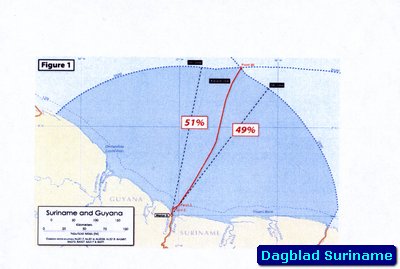 |
|
|
In de uitspraak komt het erop neer dat Suriname geen aanspraak meer maakt op het zeebodemolieveld waarop tijdens kabinet-Wijdenbosch Guyana concessie had verleend aan een Canadese multinational (CGX). Deze multinational wilde olieboringen uitvoeren, maar de Surinaamse regering stak daar een stokje voor omdat wij van mening waren dat dat gebied Surinaams territorium was. President Venetiaan zei dat we verheugd moeten zijn dat aan onduidelijkheid eindelijk een eind is gekomen. We mogen ook niet hebzuchtig zijn, zegt het staatshoofd. ‘Wat uiteindelijk volgens afgesproken regels van een ander is, mag ons niet hebzuchtig maken. In elk geval is het zo dat, laat het gebied een olierijk gebied zijn, dan zal het zeker ook zo zijn dat het Surinaams deel, dat als betwist gebied genoemd is, ook olie zal hebben.
We
accepteren de uitspraak en gaan ons niet met wrok opstellen’, zegt
de president die aangeeft dat de boorput zich slechts op 8 mijl
afstand van de grens bevindt. Het zou volgens hem best wel mogelijk
kunnen zijn dat Surinaamse olie naar het gebied stroomt. Dat gebied
zal daarom beschermd moeten worden. Deze internationale zaak heeft
ons land meer dan US$ 8 miljoen gekost. Tenminste, dat zegt mr. Hans
Lim A Po die deel uitmaakte van het juridisch team. Ook hij zegt dat
we tevreden moeten zijn met de uitspraak.
Gregory Rijssen
DNA-voorzitter Somohardjo:
‘Ik wil toch ook niet de hele wereld hebben?
Geplaatst:
21/09/2007
Paramaribo - ‘Ik wil land en volk feliciteren met het bereikte succes’, is de eerste reactie van DNA’s voorzitter Paul Somohardjo tegenover DBS. ‘Deze zaak is door het Internationale Arbitrage Tribunaal zo beslist. Wij moeten ons maar hiervoor buigen. Wij kunnen niet alles krijgen. Ik wil toch ook niet de hele wereld hebben?’, vraagt hij. Volgens hem moet Suriname blij zijn daar het land ten eerste niet meer zoveel miljoenen dollars als schadeclaim hoeft te betalen aan Guyana. ‘Ook hoeven wij niet in onzekerheid te leven, want voorheen was dat stuk gebied een betwistgebied, maar nu is de grens duidelijk getrokken en weten wij welk stuk ons toehoort en welk aan Guyana.’
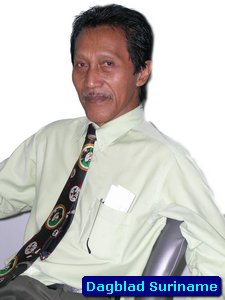 Tenslotte
dat ondanks dat het gebied waarin de boringen van enkele jaren
geleden plaats hebben gehad aan de kant van Guyana ligt, Guyana niet
zonder Suriname boringen kan plegen. ‘Guyana blijft toch afhankelijk
van Suriname’, zegt hij tevreden. Volgens de uitspraak heeft geen
van beide landen op alle punten die het bij het Arbitrage Tribunaal
heeft bepleit, zijn zin gehad. Het Internationale Arbitrage
Tribunaal heeft de precieze locatie van de zeegrens tussen Suriname
en Guyana vastgesteld vanuit het eindpunt van de landgrens (het punt
waar de landgrens eindigt en de zeegrens begint) tot aan de 12 mijl
grens van de territoriale zee en vandaar uit tot de 200 zeemijl
grens van de exclusieve economische zone en binnen diezelfde grens
van het continentaal plateau.
Tenslotte
dat ondanks dat het gebied waarin de boringen van enkele jaren
geleden plaats hebben gehad aan de kant van Guyana ligt, Guyana niet
zonder Suriname boringen kan plegen. ‘Guyana blijft toch afhankelijk
van Suriname’, zegt hij tevreden. Volgens de uitspraak heeft geen
van beide landen op alle punten die het bij het Arbitrage Tribunaal
heeft bepleit, zijn zin gehad. Het Internationale Arbitrage
Tribunaal heeft de precieze locatie van de zeegrens tussen Suriname
en Guyana vastgesteld vanuit het eindpunt van de landgrens (het punt
waar de landgrens eindigt en de zeegrens begint) tot aan de 12 mijl
grens van de territoriale zee en vandaar uit tot de 200 zeemijl
grens van de exclusieve economische zone en binnen diezelfde grens
van het continentaal plateau.
Marijan Setrodikoro
Guyanese president Jagdeo: Guyana en Suriname zijn beide winnaars
Greg Sitaram, 21/09/2007 (de Ware Tijd)
GEORGETOWN/ GUYANA - Een stoïcijnse en ingetogen president Bharrat Jagdeo van Guyana heeft zijn volk gisteren in een televisietoespraak via de staatszender voorgehouden dat Guyana door het Arbitrage Tribunaal inzake de VN Conventie over de Rechten van de Zee integraal in het gelijk is gesteld op vrijwel alle twistpunten in het maritieme grensdispuut met Suriname.
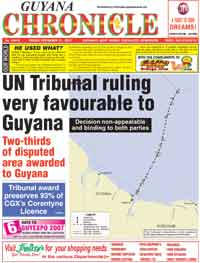 Voorpagina
Guyana Chronicle
Voorpagina
Guyana Chronicle
Hij benadrukte tegenover zijn volk dat, hoewel zijn land als winnaar uit de bus is gekomen, hij geen triomfalistische houding zal aannemen. “Ik ga niet praten over winnaars en verliezers. Dat zou niet juist zijn, omdat zowel Guyana als Suriname winnaar is. Dit, omdat beide landen op een verantwoorde en vreedzame manier geparticipeerd hebben in dit historische proces, waaruit een algemeen maritieme grens is komen vast te staan. Hierdoor komt een langdurige bron van spanning te vervallen tussen onze twee grote naties,” sprak Jagdeo heel matig.
In zijn
betoog, dat bijkans twintig minuten duurde, benadrukte hij dat het van eminent
belang is dat beide partijen zich neerleggen bij de bevindingen van het VN
tribunaal. Hij beklemtoonde dat beide landen nu op een vreedzame manier kunnen
overgaan tot de exploratie en exploitatie van hun natuurlijke hulpbronnen die
voorkomen in hun Exclusieve Economische Zone (EEZ). Jagdeo zei dat de uitspraak
aanleiding moet zijn voor een goede samenwerking tussen Suriname en Guyana in
hun streven naar economische ontwikkeling en hun relatie als goede buren. “Deze
gedachte heb ik intussen medegedeeld aan president Ronald Venetiaan van
Suriname.”
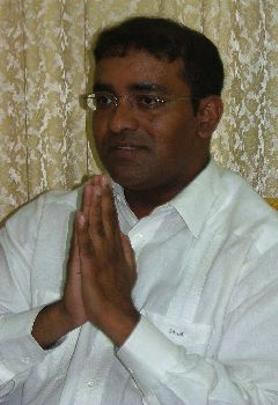
In zijn toespraak hield Jagdeo zijn volk voor dat alle vijf leden van het tribunaal het eens waren met de standpunten die Guyana innam. “De beslissing is in Guyana’s voordeel. Alle door Guyana gestelde doelen zijn behaald. Nu hebben we een definitieve en permanente maritieme grens met Suriname. Guyana beschouwt de aangewezen grens als eerlijk en rechtvaardig voor beide staten. Het tribunaal heeft in zijn beslissing alle door Guyana opgeworpen argumenten aanvaard. Nu mogen de oliemaatschappijen, aan wie Guyana toestemming had gegeven, rustig doorgaan met hun werkzaamheden.” Volgens de Guyanese president zal deze beslissing zowel Suriname als Guyana in de gelegenheid stellen om deze controverse achterwege te laten en samen te werken als goede buren.
Na het betoog van Jagdeo bleef het rustig in de straten van Guyana en was de sfeer vrij matig. De Ware Tijd had eerder uit gesprekken begrepen dat een eventuele overwinning uitbundig zou worden gevierd. Taxichauffeur Roy Singh en zijn vrouw zeggen dat ze de zege al hadden zien aankomen. Uit de gesprekken is merkbaar dat met dit resultaat en zijn gematigde houding Jagdeo politiek vrij goed heeft gescoord.-.
Bharat Jagdeo
GUYANA/SURINAME BORDER DISPUTE FINALLY SETTLED:
UN Tribunal ruling in Guyana’s favour -
(Guyana Chronicle, Sept 21 - 2007
Guyana now has undisputed title to the area where the CGX rig was exploring for oil before it was forcibly evicted by the Surinamese military forces.
“My fellow Guyanese - this has been a great day for Guyana. Now it remains for us to lay the foundation for a long future of harmonious relations and practical cooperation with our brothers and sisters in Suriname - to whom, on your behalf, I extend the hand of friendship” – PRESIDENT BHARRAT JAGDEO
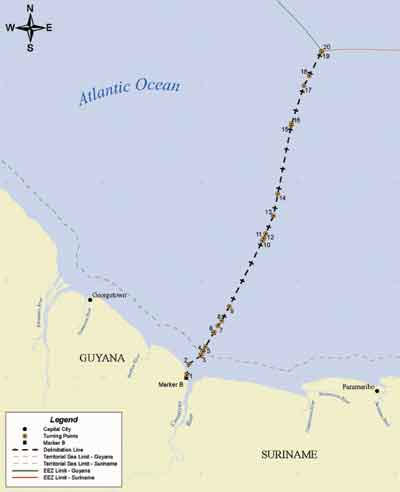 PRESIDENT
Bharrat Jagdeo yesterday announced that Guyana is “very pleased” with the
judgment of the Guyana/Suriname border dispute by the United Nations
International Tribunal on the Law of the Sea based in Hamburg.
PRESIDENT
Bharrat Jagdeo yesterday announced that Guyana is “very pleased” with the
judgment of the Guyana/Suriname border dispute by the United Nations
International Tribunal on the Law of the Sea based in Hamburg.
The long-awaited and much-anticipated announcement of the decision on the Guyana/Suriname border dispute by the UN International Tribunal, was made public by President Jagdeo during an address to the nation yesterday afternoon.
“Guyana, which initiated this judicial process to settle once and for all any dispute over the maritime boundary with Suriname, is very pleased with the judgment. Guyana is particularly pleased that the Award was unanimous, with all five arbitrators signing on to it,” President Jagdeo declared.
According to the President, the Award, which is unanimous and legally binding, is in the interest of both our countries and the wider Caribbean and is one that “satisfies every one of Guyana’s objectives on all six of the core issues at the heart of the case”.
“When I say that on all these central issues Guyana’s interests and objectives are met, I do not mean to be triumphalist. That, in any event, would not be a proper posture for our country to adopt.”
“In fact, the Award is in the interest of both our countries and the wider Caribbean,” the Guyanese Head of State posited.
He also announced that the UN Tribunal has stated clearly that “Guyana now has undisputed title to the area” where the CGX rig was exploring for oil before it was forcibly evicted by the Surinamese military forces.
“In fact, that area lies a full 15 kilometres to the west of the boundary established by the Arbitral Tribunal, and is therefore well within Guyana’s waters,” Mr. Jagdeo said.
He noted, too, that the Tribunal’s Award is effective immediately, and Guyana looks forward to the prompt and successful resumption of petroleum exploration activities in these waters.
Following is the address to the nation by President Jagdeo yesterday afternoon on the award of the Guyana-Suriname Arbitral Tribunal.
“Fellow Guyanese – at precisely 4:00 p.m. (16:00 hours) Guyana time today, the Guyana-Suriname Arbitral Tribunal established under the United Nations Convention on the Law of the Sea made public its Final Award, which is unanimous and legally binding on both Parties.
After several thousand pages of written submissions contained in 13 printed volumes of ‘pleadings’; after scrutiny of literally hundreds of maps, old and new; after nearly three weeks of Oral Hearings last December, which followed earlier sessions in The Hague; after innumerable hours of analysing the law and the facts pertinent to the case - the Tribunal in its binding Award has defined the maritime boundary between Guyana and Suriname - as Guyana invited it to do three and a half years ago, when it initiated these arbitral proceedings under the United Nations Convention.
The Tribunal’s Award is contained in a volume of 167 pages, many of which are inevitably cast in highly technical, legal, geographic and cartographic terms, and it includes 5 maps.
“Guyana, which initiated this judicial process to settle once and for all any dispute over the maritime boundary with Suriname, is very pleased with the judgment. Guyana is particularly pleased that the Award was unanimous, with all five arbitrators signing on to it,” President Jagdeo declared.
The Award is very favourable to Guyana. In particular, all of Guyana's principal objectives have been achieved. Most notably, we now have a definitive and permanent maritime boundary with Suriname. Guyana regards that boundary as fair and equitable to both States.
The Award has taken Guyana's major arguments fully into account, and now allows Guyana's licensees to resume their petroleum exploration activities in the part of the sea that Guyana has claimed, out to a distance of 200 miles from the coast, in accordance with international law.
The resolution of this dispute, which is now final and binding on the parties, will allow Guyana and Suriname to put this controversy behind them, and to proceed to cooperate as good neighbours on a wide range of issues.
Now, let me try to explain all this briefly, in layman’s terms, and leave it to the members of our Legal Team to elaborate. They will be available to answer questions from the news media tomorrow afternoon (today).
There were six core issues in this case, and Guyana’s interests and objectives have been met in each.
They were - 1. To establish that the Rule of International Law, not the rule of force, holds sway in CARICOM waters; and more specifically in the maritime areas of Guyana and Suriname.
2. To draw the boundary between the maritime areas of Guyana and Suriname in a manner that would be binding on both countries for all time and acknowledged by the international community.
3. To confirm that the line of the boundary would be influenced, above all, by the principle of equidistance for which Guyana had long contended and for which Guyana’s national law provides.
4. To secure Guyana’s sovereignty to the resources of the sea-bed on its continental shelf on the basis of an internationally recognized maritime boundary.
5. To enable Guyana’s licensees to return to the offshore area where they were exploring for oil in June 2000, when they were forced at gunpoint by a Surinamese naval vessel to abandon their activities and evacuate the area.
6. To achieve all this in a manner which allows Guyana and Suriname to cooperate as good neighbours and CARICOM partners in the development of their countries.
When I say that on all these central issues Guyana’s interests and objectives are met, I do not mean to be triumphalist. That, in any event, would not be a proper posture for our country to adopt.
In fact, the Award is in the interest of both our countries and the wider Caribbean. Let me explain why the Award satisfies every one of Guyana’s objectives on all six of the core issues at the heart of the case.
As to Core Issue 1: (Upholding the rule of law ) Suriname’s action on June 3, 2000 in interrupting the activities of the oil rig CE Thornton effectively prevented any further exploratory work in that maritime area – by anyone.
It certainly set back Guyana’s economic development. If that action was left as the determinant of the status quo, there would have been irreparable damage to Guyana’s development.
Moreover, left unchallenged, it undermined the purposes of the UN Convention on the Law of the Sea of which both Guyana and Suriname (and most of the world’s countries) are signatories.
The Tribunal has found that the expulsion of the CGX oil rig by Suriname on June 3, 2000 (I quote) ‘constituted a threat of the use of force in breach of the Convention (on the Law of the Sea), the UN Charter, and general international law’ (end of quote).
The Tribunal’s Award has confirmed the rule of law in CARICOM’s maritime areas.
So, on Core Issue 1, Guyana has achieved its objectives. As to Core Issue 2: (Fixing a maritime boundary) Guyana’s resort to compulsory arbitration under the Law of the Sea Treaty came after extensive efforts to resolve this issue bilaterally.
Suriname did not want the maritime boundary to be established by the Tribunal despite the damage a continuing maritime dispute would cause. Suriname actually tried to prevent the Tribunal from reaching a conclusion on the merits of the case.
It did so by arguing that the Tribunal had no jurisdiction to fix the maritime boundary – a step which inevitably lengthened the period and increased the costs of the arbitral process.
Guyana’s Legal Team argued strenuously against this. In the end, Guyana succeeded. The Tribunal found that it had jurisdiction and has authoritatively established the maritime boundary between Guyana and Suriname. It has placed the matter beyond dispute.
So on Core Issue 2, Guyana has achieved its objectives. As to Core Issue 3: (Where the boundary is) From the time of the establishment of the International Regime on the Law of the Sea in the 1950s, Guyana has asserted its acceptance of the principle of equidistance – a technical term for a method of establishing an equitable maritime boundary between neighbouring states, by drawing a boundary line in the sea that is at all points equidistant from the coastlines of both States.
It is the most widely accepted method in the international community although there are variations in particularly complex coastlines.
In the case of Guyana and Suriname, whose coastlines are relatively regular, it produces a line that runs in a north-easterly direction from the coast; and Guyana has been guided by it consistently.
Suriname has argued for a boundary line that is more northerly; one that would therefore enlarge Suriname’s maritime area.
They argued that the boundary line between Guyana’s and Suriname’s territorial waters that was fixed in 1936 along a 10 degree North line for a distance of only 3 miles, because of considerations of the channel in the mouth of the Corentyne River, should be extended along the same 10 degree axis beyond the 3 mile limit previously agreed all the way to the 200-mile limit of the Exclusive Economic Zones claimed by both Guyana and Suriname.
The Tribunal has rejected this argument, and in the area beyond 3 miles from the shore it has drawn the boundary in a more north-easterly direction for the remaining 197 miles, as Guyana had requested, using the principle of equidistance as its basic guide. That principle was enshrined in the law of Guyana since 1977 – in our Maritime Boundaries Act; and has always guided our conduct.
So, on Core Issue 3, Guyana has achieved its objectives As to Core Issue 4: (Guyana’s sovereignty to the resources of the sea-bed). The UN Convention on the Law of the Sea establishes that, in its Exclusive Economic Zone and Continental Shelf as delimited under the Convention, Guyana has ‘sovereign rights’ of exploration and exploitation of the resources of the sea-bed and sub-soil of the Zone, and of the waters above them.
The Exclusive Economic Zone runs outwards from Guyana’s territorial sea up to a distance of 200 miles and is bounded on the lateral side with Suriname by the maritime boundary that the Tribunal has established.
Guyana’s sovereign rights to explore and exploit the hydrocarbon resources within the boundaries of the Exclusive Economic Zone and Continental Shelf, once contested by Suriname, are now settled on the basis of the Tribunal’s Award.
So, on Core Issue 4, Guyana has achieved its objectives. Core Issue 5: (Return of Guyana’s licensees to the disputed area.) The Tribunal’s Award has made it possible for CGX and other licensees to resume their petroleum exploration activities on Guyana’s side of the equidistance line, which as of today constitutes the definitive lawful and internationally recognised boundary between Guyana and Suriname.
The Tribunal has stated clearly that “Guyana now has undisputed title to the area” where the CGX rig was exploring for oil before it was forcibly evicted by the Surinamese military forces. In fact, that area lies a full 15 kilometres to the west of the boundary established by the Arbitral Tribunal, and is therefore well within Guyana’s waters.
The Tribunal’s Award is effective immediately, and Guyana looks forward to the prompt and successful resumption of petroleum exploration activities in these waters.
So on Core Issue 5, Guyana’s objectives have been achieved. Core Issue 6: (Guyana-Suriname relations going forward). As I explained when I announced the filing of Guyana’s Claim on February 25, 2004, Guyana saw the proceedings before the Tribunal ‘not as an adversarial process, but one designed to establish a sound basis for economic development in the maritime regions of both Suriname and Guyana’.
Throughout the proceedings, Guyana conducted itself in that manner, and now that they are ended we look to the future as a new era of cooperation with Suriname, both within CARICOM and bilaterally. Both Guyana and Suriname are pledged and obligated by international law to accept and respect the Tribunal’s Award.
I have already explained how satisfied Guyana is with the Award on every one of the Core Issues before the Tribunal. I have deliberately not spoken of ‘winners and losers’; that would not be appropriate, because in a very important sense both Guyana and Suriname are winners - for having participated responsibly and peacefully in this historic process, and for having emerged with a common maritime border that puts an end to this longstanding source of tension between our two great countries.
The great achievement of the Award is to open up before Guyana and Suriname the prospect of practical harmonious cooperation in their economic development and in their relations as good neighbours. I have already conveyed these sentiments to President Venetiaan.
So, on Core Issue 6, Guyana has achieved its objectives, and both Guyana and Suriname have prevailed. It remains for me to thank Guyana’s Legal Team whose members have worked with commitment and professionalism over the last three and a half years to make today’s result possible: to our Co-Agents Sir Shridath Ramphal, Mr. Paul Reichler of the Foley Hoag law firm in Washington, and Professor Payam Akhavan of McGill University in Montreal.
I also want to thank Professor Philippe Sands of University College, London and Professor Nico Schrijver of Leiden University in the Netherlands, and our Cartographic experts Dr. Galo Carrera and Mr. Scott Edmonds.
I commend, too, Guyana’s Ministry of Foreign Affairs, Minister Rudy Insanally and his officers who worked tirelessly in support of our Legal Team.
And special thanks are due to Guyana’s Licensee, CGX, for its patience and support over the years it has taken to see this matter through to today’s satisfying completion.
Finally, I offer the appreciation of the Government and people of Guyana to the Chairman of the Arbitral Tribunal, Judge Dolliver Nelson, and to each of the four other distinguished Members of the Tribunal, for the erudition and justice of their Award, and to the Secretariat of the Permanent Court of Arbitration in The Hague, for their professional, balanced and extremely efficient performance throughout these historic proceedings.
My fellow Guyanese - this has been a great day for Guyana. Now it remains for us to lay the foundation for a long future of harmonious relations and practical cooperation with our brothers and sisters in Suriname - to whom, on your behalf, I extend the hand of friendship.”
Tribunal award preserves 93% of CGX’s Corentyne Licence CGX Energy Inc in a statement following the UN Tribunal on the Law of the Sea decision on the Guyana/Suriname border dispute said it is pleased with this development and noted that the award preserves 93% of its Corentyne Licence.
“Looking forward, if an offshore discovery is made in either Guyana or Suriname, it could lead to many more throughout the basin. Significant employment, infrastrucuture and service sector opportuities willevolve to support the dynamic exploration and development will follow. The combined resources of both countries will be required to support the evolution of a new petroleum in the Guyana/Suriname basin,” CGX noted.
CGX holds an interest in four Production Sharing Licences from the Government of Guyana, covering 8.7 million acres onshore.
Other companies holding licences in the area of overlapping border claims are Maxus Guyana Ltd, a subsidiary of Repsol YPF and Esso Exploration and Production Guyana Ltd.
|
|
E-mail: info@nickerie.net
Copyright © 2007. All rights reserved.
Designed by Galactica's Graphics